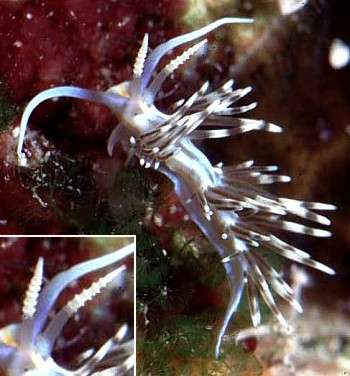
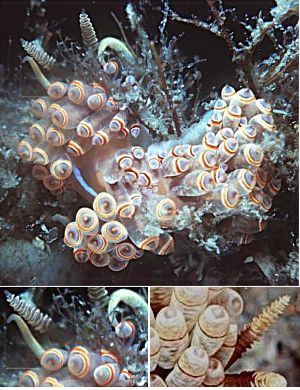
Dondice occidentalis
(Engel, 1825)
Order: NUDIBRANCHIA
Suborder: AEOLIDINA
Family: Glaucidae
DISTRIBUTION
Recorded from Brazil (Sao Paulo) to North Carolina, USA, and many parts of the Caribbean.
PHOTO
UPPER: Ranguana Caye on hydroids, Belize, Caribbean Sea, 1992. Size range from 14 - 20 mm. PHOTO: Jeff Hamann.
LOWER: off West Palm Beach, Florida, USA, in about 10 feet of water. From 1/2 inch to 1 inch long. Insets showing colour variation in 2 animals. PHOTO: Anne Dupont.
Body translucent with following markings. On head there is a median line of variable width, running from the anterior edge to just behind the rhinophores. This ranges in colour from red to orange or yellow. Behind the rhinophores there is usually a white broken line down the dorsal midline, but it can sometimes be absent. There is a line on each side of the body from the head to the tail but usually broken beneath the ceratal groups. It also ranges in colour from red to yellow and has been reported to be white or absent in some cases. In other cases there is a yellow and a white line along each side.
The cerata can have broad white bands or white blotches covering the upper two thirds and sometimes there is a bright red or orange band near the tip. Another character mentioned by some authors is that the jaws plates are covered by a black epithelium which can show through the body wall as a black patch on each side of the head. The rhinophores are annulated with up to 18 rings.
References:
• Edmunds,M (1964): Eolid mollusca from Jamaica, with descriptions of two new genera and three new species. Bulletin of Marine Science of the Gulf and Caribbean, 14(1): 1-32
• Eyster,LS (1980): Distribution and reproduction of shell-less opisthobranchs from South Carolina. Bull. Mar. Sci., 30(3): 580-599.
• Marcus, Er (1958) On western Atlantic opisthobranchiate gastropods. Am. Mus. Novit., 1906: 1-82.
• Marcus, Er (1961) Opisthobranchia from North Carolina. Journal Elisha Mitchell Scientific Society, 77(2): 141-151.
• Marcus, Ev (1977) An annotated checklist of the western Atlantic warm water opisthobranchs. J. Moll. Stud. (Suppl. 4): 1-23.
• Marcus, Ev & Marcus, Er (1960) Opisthobranchs from American Atlantic warm waters. Bull. Mar. Sci., 10(2): 129-203.
• Marcus, Ev & Marcus, Er (1963) Opisthobranchs from the Lesser Antilles. Studies on the Fauna of Curacao and other Caribbean Islands, 19: 1-76.
• Marcus, E. & Marcus, E (1970) Opisthobranchs from Curacao and faunistically related regions. Studies on the Fauna of Curacao and other Caribbean Islands, 33: 1-129.
• Thompson,TE (1980): Jamaican opisthobranch molluscs: II. J. Moll. Stud., 46(1): 74-99.
Rudman, W.B., 2001 (August 1) Dondice occidentalis (Engel, 1825). [In] Sea Slug Forum. Australian Museum, Sydney. Available from http://www.seaslugforum.net/find/dondocci
Related messages
Re: Dondice occidentalis from Massachusetts?
March 18, 2010
From: Emily Keen
Concerning message #23258:
Dear Bill,
Thank you for your help. Dr. Pierce also mentioned to me today that this sea slug was not only shipped with Tubularia, but was also eating Tubularia. I do not know if this information will make a difference in your identification of this sea slug.
Thank you,
Emily Keen
emilykeen@mail.usf.edu
Keen, E., 2010 (Mar 18) Re: Dondice occidentalis from Massachusetts?. [Message in] Sea Slug Forum. Australian Museum, Sydney. Available from http://www.seaslugforum.net/find/23280Dear Emily,
McDonald & Nybakken's invaluable compilation of feeding records [http://www.theveliger.org/nudibranch_food.html] include as food for Dondice occidentalis a hydroid (Eudendrium sp.) and an unlikely bryozoan (Zoobotryon sp). All this really tells us is what we already know - we don't know much in detail about the food of individual nudibranch species.
I am pretty sure your animal is Dondice occidentalis so I guess we can add Tubularia sp to the feeding list.
Best wishes,
Bill Rudman
Dondice occidentalis from Massachusetts?
February 22, 2010
From: Emily Keen
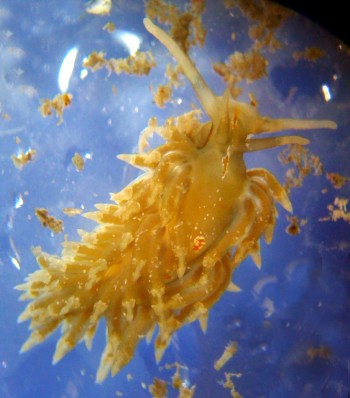
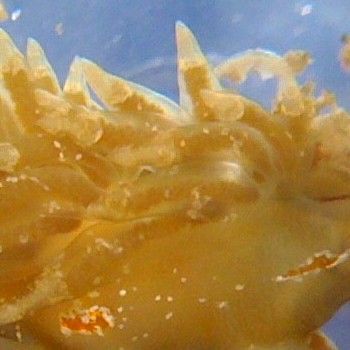
In our collections for our Advanced Invertebrate Zoology lab at the University of South Florida our professor, Dr. Pierce, stumbled upon this stowaway slug. The pictures are from under a dissecting microscope. My TA, Laura Bedinger, was able to provide more information about where it may have come from in hopes that will help to identify this slug. This sea slug was shipped by The Marine Biological Lab at Woods Hole. It shipped in as a surprise bonus with Tubularia. I hope this helps! Thanks!
18 February 2010. Photographer: Emily Keen.
Possibly a Facelina bostoniensis?
I hope this helps!
Thanks!
Emily Keen.
emilykeen@mail.usf.edu
Keen, E., 2010 (Feb 22) Dondice occidentalis from Massachusetts?. [Message in] Sea Slug Forum. Australian Museum, Sydney. Available from http://www.seaslugforum.net/find/23258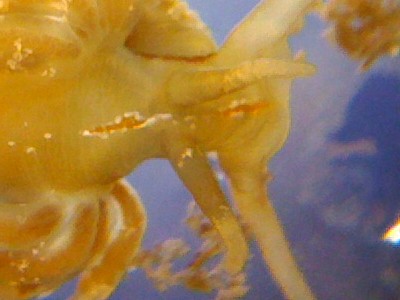
Dear Emily,
I assume that if it was shipped by The Marine Biological Lab at Woods Hole then it come from the Woods Hole, Massachusetts region. I am not an expert on the species from the east coast of North America so I hope someone will correct me if I am wrong, but my first thought is that this is Dondice occidentalis? It is quite variable in colour but it can have a coloured median line down its back which is sometimes white or bluish white and sometime yellow or orange with or without a white or bluish-white border. The line can be entire or broken into a number of elongate patches. Your animal certainly has traces of this ornage median line bordered with white. It also has an orange line on each side of the head which runs down each side below the cerata. D. occidentalis has up to 18 annulations or rings on the rhinophores - I can see traces of wrinkles in your photos but I am nor sure if they count as 'annulations'.
If your animal does turn out to be this species, it is from quite a bit further north than it is usually recorded.
Best wishes,
Bill Rudman
Dondice occidentalis from North Carolina
October 1, 2009
From: Marcel Tanke
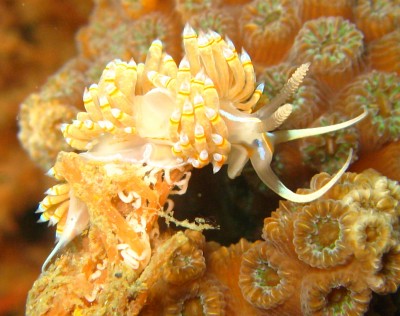
Concerning message #13715:
Dear Bill,
For the record, a couple of pictures of Dondice occidentalis from North Carolina. The first one is laying eggs. The white lines, in between the rhinophores and the edge of the mantle are clearly visible.
The rhinophores are annulated and the cerata are grouped in a few "patches".
Locality: Wreck "Indra", 15 meters, North Carolina, Atlantic Ocean , 28 Juni 2009, Wreck on sandy bottom . Length: first 2.5 cm, second 1 cm. Photographer: Marcel Tanke.
Best regards,
Marcel
marceltanke@cs.com
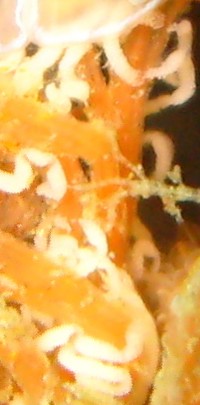
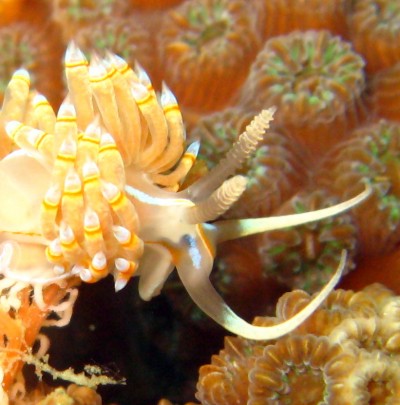
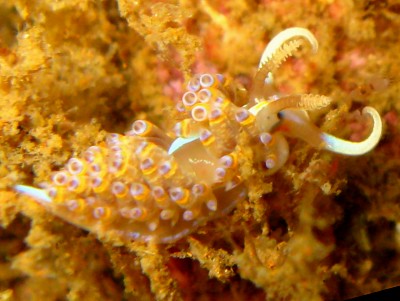
Dear Marcel,
It's good to get some more photos of this somewhat variably coloured species. I have included a couple of close-ups to show the detail on the head and the egg ribbon.
Best wishes,
Bill Rudman
Dondice occidentalis defensive behavior
November 23, 2006
From: Tony Fernando
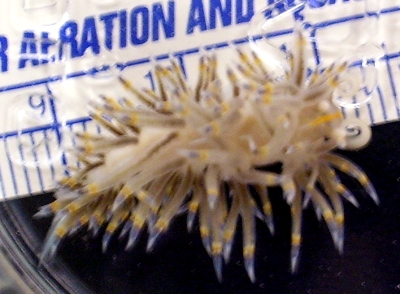
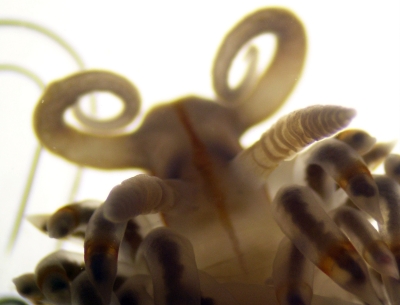
Hi Dr. Rudman,
Attached please find photographs of a specimen of Dondice occidentalis that we collected from our raw water upweller. (Water received from Bogue Sound)
Locality: Morehead City, upweller, North Carolina, USA, Bogue Sound, 17 November 2006, raw water (unfiltered) upweller . Length: 25 mm approx. Photographer: Tony Fernando.
We did notice that while all three of the other species we've collected here tend to contract into a ball when handled or disturbed, this one bristles like a hedgehog. The upper photo is a picture of the animal just after being prodded by a pipette and was taken within a minute of the lower photo.
I also have video of the reation, but those files are very large. Also attached is a closeup through the disection scope showing the medial stripe and rhinopores.
Tony Fernando
anthonyfernando@yahoo.com
Fernando, A.V., 2006 (Nov 23) Dondice occidentalis defensive behavior. [Message in] Sea Slug Forum. Australian Museum, Sydney. Available from http://www.seaslugforum.net/find/18478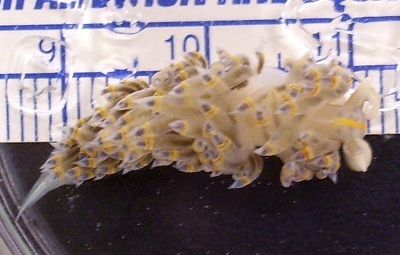
Dear Tony,
Thanks for these observations. Quite a few species of this group of aeolids [Family Glaucidae] erect their cerata when disturbed. Have a look at the Defence Fact Sheet for some links. One good example isMoridilla brockii which has some large red tipped cerata which are usually curled out of the way but uncoil and bristle 'fiercely' when the animal is disturbed. Another species I first found in Tanzania erects all its long cerata and shakes them in the direction of the potential threat. Like your comparision with a hedgehog, it reminded me of the way porcupines shake and shiver their spines in defence, so I named it Sakuraeolis nungunoides, as nungunungu is the Swahili name for the porcupine.
Best wishes,
Bill Rudman
Dondice occidentalis from Florida
May 7, 2005
From: Jeff Goddard
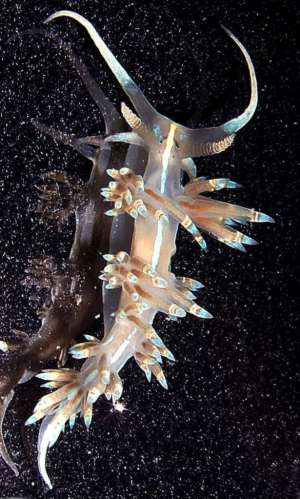
Hi Bill,
Kevin Johnson and his Biological Oceanography students at the Florida Institute of Technology also found this aeolid on their field trip to Sebastian Inlet last week. I'm no expert on the fauna of the western Atlantic, but I believe this is Dondice occidentalis. Given the details visible, as well as the color pattern of this particular individual, I thought Kevin's photo would make a useful addition to the Forum's information on this species.
Locality: Sebastian Inlet, Florida, USA. Atlantic Ocean. Depth: Low intertidal. Length: unknown. April 2005. rocky/sandy. Photographer: Kevin Johnson.
Best wishes,
Jeff
goddard@lifesci.ucsb.edu
Goddard, J.H.R., 2005 (May 7) Dondice occidentalis from Florida. [Message in] Sea Slug Forum. Australian Museum, Sydney. Available from http://www.seaslugforum.net/find/13715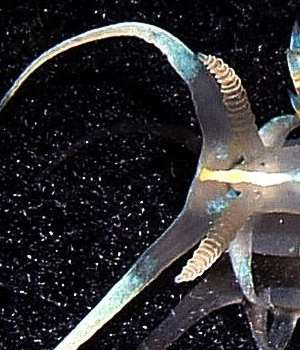
Thanks Jeff,
Yes this is a nice addition. I have included a close-up of the head alonmgside to show the lamellae on the rhinophores
Best wishes,
Bill Rudman
Re: Dondice occidentalis feeding
March 23, 2004
From: Marina Poddubetskaia
Dear Bill,
Concerning your question [#12498]:
I've checked all my photos of Dondice occidentalis and I can't find a better view of these polyps. When I photographed this animal I believed they were an hydroid. Sorry, but I can't tell you more about it.
Cordially,
Marina.
nembro@nembro.info
Poddubetskaia, M., 2004 (Mar 23) Re: Dondice occidentalis feeding. [Message in] Sea Slug Forum. Australian Museum, Sydney. Available from http://www.seaslugforum.net/find/12517Thanks Marina,
I suspect it is a hydroid but can't clearly make out a stalk. Whatever it is, it is obviously eating one!
Cheers
Bill Rudman
Dondice occidentalis from Bahamas
March 22, 2004
From: Marina Poddubetskaia
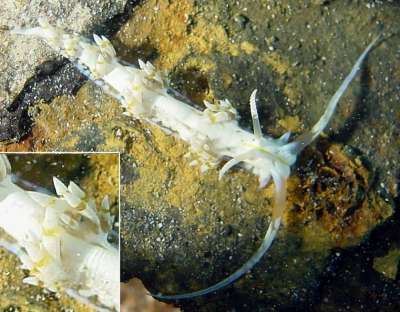
Dear Bill,
I've found this Dondice occidentalis in the Southern Bahamas during a night dive. The head of this specimen is strange because it is so wrinkled. I can't see this character in other photos on the Forum. I've sent a second message [#12498] showing it feeding.
Date: February 02, 2004
Location: Great Exuma, Bahamas, Western Atlantic
Site: Stocking Island, Hole n°2
Depth: 4m
Size: about 30mm
Photos: Marina Poddubetskaia - Nembro website
Cheers,
Marina.
nembro@nembro.info
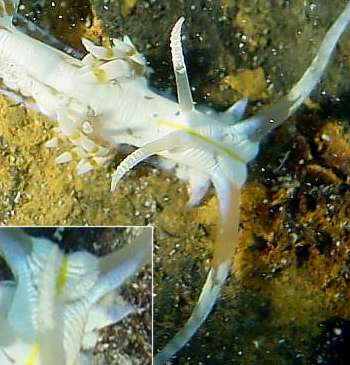
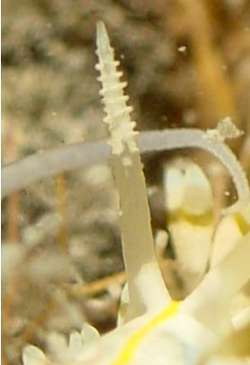
Thanks Marina,
This species certainly seems to be one of the rare species with a great variability in colour pattern. The very long oral tentacles, the lamellate rhinophores and the yellow-red median line on the head seem to be the consistent external features. I have no idea why your animal is so wrinkled
Best wishes
Bill Rudman
Dondice occidentalis feeding
March 22, 2004
From: Marina Poddubetskaia
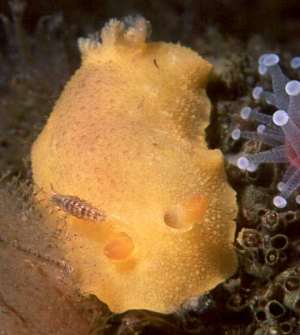
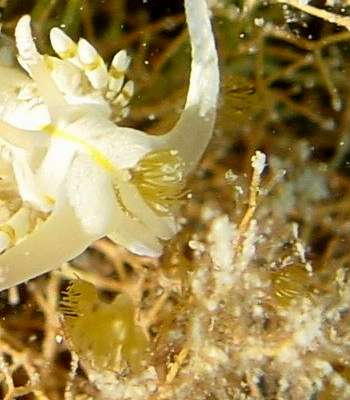
Dear Bill,
To accompany my message [12420] about finding Dondice occidentalis in the Southern Bahamas, here is a photo which looks like a feeding record. What do you think about it?
Date: February 02, 2004
Location: Great Exuma, Bahamas, Western Atlantic
Site : Stocking Island, Hole n°2
Depth: 4m
Size: about 30mm
Photos: Marina Poddubetskaia - Nembro website
Cheers,
Marina.
nembro@nembro.info
Marina Poddubetskaia , M., 2004 (Mar 22) Dondice occidentalis feeding. [Message in] Sea Slug Forum. Australian Museum, Sydney. Available from http://www.seaslugforum.net/find/12498Dear Marina,
It certainly looks like it is eating these polyps. What I can't quite make out from your photos is whether these polyps are of a brown anemone or of a large solitary hydroid like Ralpharia or Tubularia. Can you remember if they were on a long stalk? I suspect the polyp is a large solitary hydroid because anemone-feeding aeolids usually belong to the family Aeolidiidae, but I guess there can always be exceptions
Best wishes
Bill Rudman
Dondice occidentalis from Southern Bahamas
November 25, 2003
From: Anne DuPont
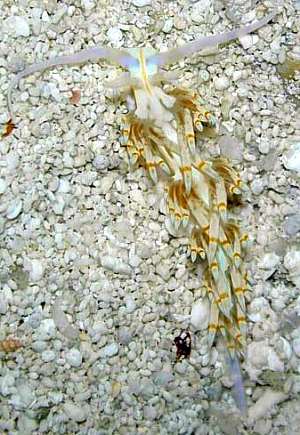
Dear Bill,
This photo of Dondice occidentalis was taken off Stocking Island, Exumas, Bahamas in February, 2003.
I was snorkeling in about 3 feet of water when I found it crawling on the sand. It was about one inch long,
Colin Redfern has photos of Dondice occidentalis in his book Bahamian Seashells from the northern Bahamas, and I was delighted to find this one in the southern Bahamas. This was the only specimen I found.
Cordially,
Anne DuPont
Delray Beach, Fl (USA)
akdupont@bellsouth.net
DuPont, A., 2003 (Nov 25) Dondice occidentalis from Southern Bahamas. [Message in] Sea Slug Forum. Australian Museum, Sydney. Available from http://www.seaslugforum.net/find/11497Thanks Anne,
Apart from a new record, it's good to get photos of more animals as we are starting to find intermediate colour forms which are linking the more extreme colour patterns together.
Best wishes
Bill Rudman
Dondice occidentalis with eggs
November 25, 2003
From: Anne DuPont
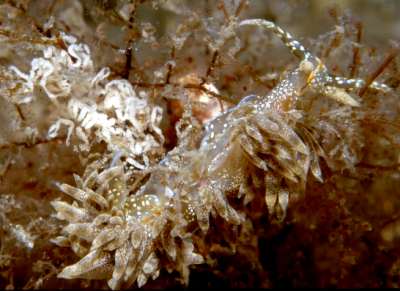
Dear Bill,
On a night dive in West Palm Beach, Florida (USA) I found this Dondice occidentalis with eggs. It was on the same hydroids and in the same area that we have found the two different variations of Dondice occidentalis. [August 1, 2001 message; September 27, 2002 message]
The photo was taken October 11, 2003 in 10 feet of water.
Thank you for the wonderful forum.
Cordially,
Anne DuPont
Delray Beach, Florida (USA)
akdupont@bellsouth.net
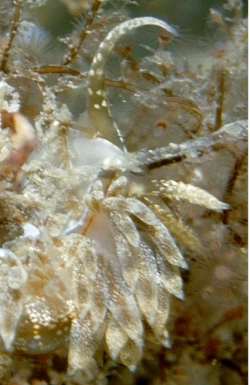
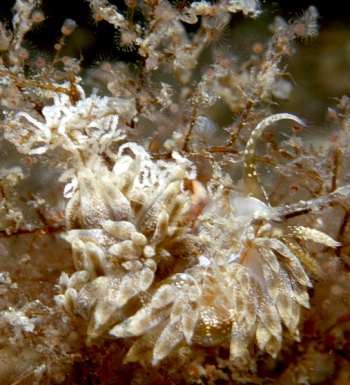
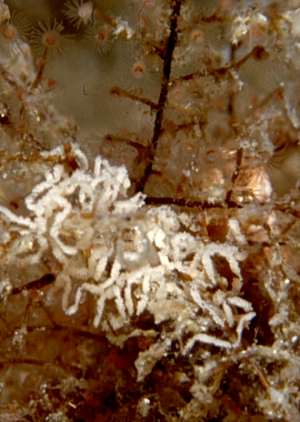
Thanks Anne,
Bill Rudman
Dondice occidentalis? from Jamaica
October 20, 2003
From: Ross W. Gundersen
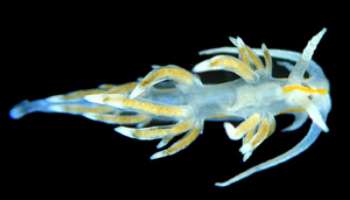
Dear Bill:
Here is another sea slug from Jamaica. As I said in my first message, all specimens were collected from St. Ann's Bay, Jamaica, West Indies. Most specimens were collected using a light weight dredge and photographed by R. Gundersen.
I think it is Phidiana lynceus. Dredged at 5 m depth in Thallassia.
Best wishes,
Ross
ross.gundersen@uwp.edu
Gundersen, R.W., 2003 (Oct 20) Dondice occidentalis? from Jamaica. [Message in] Sea Slug Forum. Australian Museum, Sydney. Available from http://www.seaslugforum.net/find/11257Dear Ross,
It is difficult to be sure from a small photo and from its proportions, probably a juvenile animal but I think this is probably Dondice occidentalis. The orange lines on the head are characteristic and their are signs of some ridges on the rhinophores.
Best wishes
Bill Rudman
Re: Mystery aeolid from Florida
September 27, 2002
From: Anne DuPont
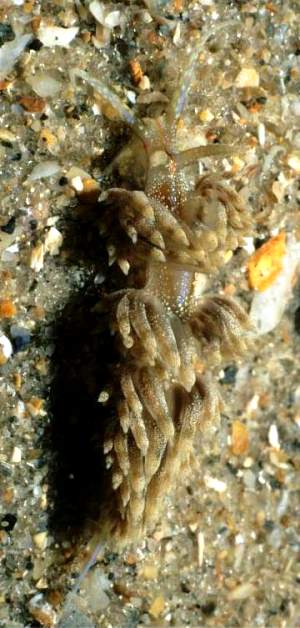
Dear Bill,
Thank you for the post on September 20, of my "Mystery aeolid from Florida."
This past Saturday night, September 21, we were able to find them again, in the same location, in about 12 feet of water, West Palm Beach, Florida. This speciman was about 1 inch long, and was on the same hydroids along with a smaller one.
On this photo you can better see the rhinophores.
Thank you.
Anne DuPont
Delray Beach, Fl., USA
akdupont@bellsouth.net
DuPont, A., 2002 (Sep 27) Re: Mystery aeolid from Florida. [Message in] Sea Slug Forum. Australian Museum, Sydney. Available from http://www.seaslugforum.net/find/8063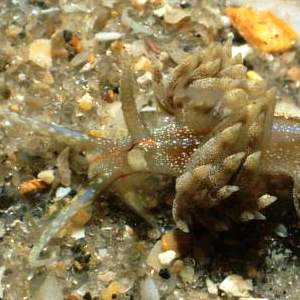
Dear Anne,
I'm glad I said "There is a possibility it is a form of Dondice occidentalis" as I suspect that is what it is. I can certainly see the rhinophores more clearly in this photo and they defintitely have lamellae rather than papillae. I have looked again at your original photos and they still look papillate - which only goes to show how risky it is to identify things from photos. Dondice occidentalis certainly seems to be a very variably coloured species
Best wishes,
Bill Rudman
Mystery aeolid from Florida
September 20, 2002
From: Anne DuPont
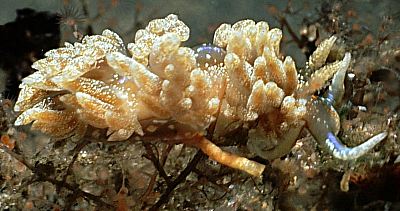
Dear Bill,
We found this nudibranch last Saturday night, September 7, 2002, West Palm Beach, Florida, in 12 feet of water on a night dive.
It was on the same hydroids that we find the Dondice occidentalis feeding on. Can you identify this nudibranch?
Thank you again for all your help.
Cordially,
Anne DuPont
Delray Beach, Fl, USA.
akdupont@bellsouth.net
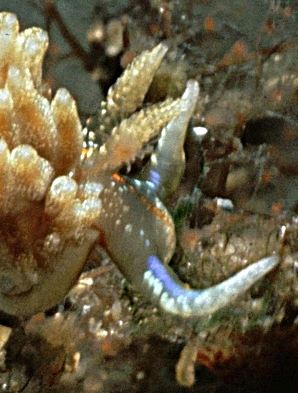
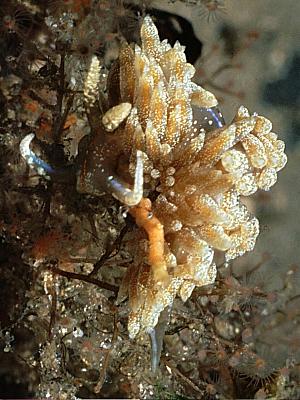
Dear Anne,
There is a possibility it is a form of Dondice occidentalis. It has an orange median line on the head and another on each side of the head, and a median white line on the dorsum behind the rhinophores, which are all features of some specimens of D. occidentalis. However from my interpretation of your photos the rhinophores are not lamellate, as occurs in D. occidentalis, but tuberculate.
I thought the tuberculate rhinophores might give me a clue but they lead me to a number of poorly described names. I wish people would realise how important a good description of the external animal is when describing species.
Caribbean species with tuberculate rhinophores;
• Facelina agari Smallwood, 1910 : brown with white spots on cerata and body
• Berghia creutzbergi Marcus & Marcus, 1970 : brown with white spots on cerata and body
• Berghia benteva (Marcus, 1958) : translucent white with white browns spots on cerata
• Moridilla kristenseni Marcus, 1963 : light yellow with silvery white net and black stipples on cerata
• Palisa papillata Edmunds, 1964 : body silvery gray... whole of dorsal surface including cerata.. covered with a network of fine white lines.... digestive gland duct in cerata pale buffish with dark brown spots.
Only Edmunds' original description gives adequate information on the living animal. Facelina agari [F. Glaucidae] and Berghia creutzbergi [F. Aeolidiidae] have white spots like your animal. I suspect your animal is likely to be a glaucid, since it is on hydroids, so I guess that excuses B. creutzbergi. It could be Facelina agari, but there is really no way of knowing just what Smallwood's description refers to.
Distinguishing features of your species seem to be the the red-orange median line on the head, a similar line on each side of the head, the white spots, the blue line on the oral; tentacles and the papillate rhinophores. I don't think this species has been described before, but it really depends on whether the rhinophores are lamellate or tuberculate [papillate].
Best wishes,
Bill Rudman
Dondice occidentalis from Florida
August 1, 2001
From: Anne DuPont
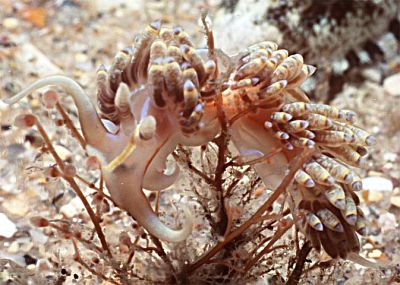
Hi Bill,
How are you and things at the museum? Hope you are having a good summer.
Is this Favorinus auritulus? I took the photos off West Palm Beach, Florida, USA, in about 10 feet of water. The ones I have photographed range in size from 1/2 inch to 1 inch long. We always find them on the hydroids on night dives and we find them with the cerata in several colors, blue, yellow and red. I'm sending you 3 photos to help you with the identification. Thank you again for all the work you do on the Forum.
Best wishes,
Anne DuPont
Delray Beach, Florida, USA
adupont@gate.net
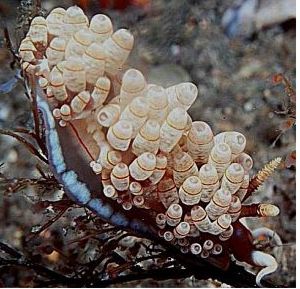

Dear Anne,
Thanks for the photos and your wishes for a good summer. Unfortunately down here it is winter - and last weekend the sea was very wild with a 10-18m swell (30 - 50+ ft) - ferries with broken windows, the port closed to all shipping. I guess it will have made a mess of the intertidal and shallow sublittoral. The waves and moving rocks tend to grind living things to pulp in these conditions.
Now back to your animals. I am pretty sure these are Dondice occidentalis. This species is very variable in colour and I have tried to summarise that variation at the top of the page. Your photos show a nice range in colour variation. They are definitely not Favorinus auritulus which has a couple of bulbous swellings on the rhinophores, rather than many rings, and like all Favorinus, it usually feeds on the eggs of other sea slugs, not on hydroids.
Best wishes,
Bill Rudman
Dondice cf. occidentalis from Brasil
June 12, 2000
From: Carlo Magenta-da-Cunha
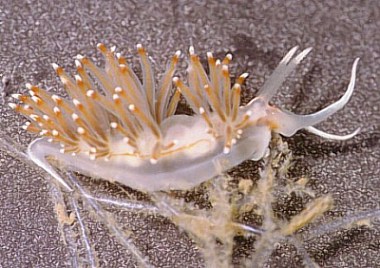
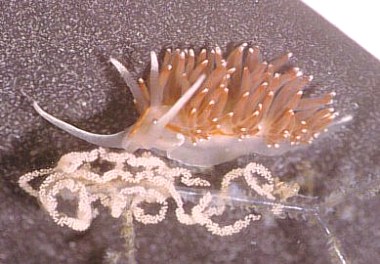
Dear friends
This specimen is very abundant here. It is found to about 10-12 m deep and I find specimens from 5-30 mm in length. In the region is like swamp area covered with mangroves.
Look to the "...a median red stripe along the head and a stripe along each side...".
Many boats with nets to catch shrimp work in this area. I have samples every week, with specimens dead and alive. My question is how can I make use of these samples? At present I'm only measuring these specimens.
I'm would like some suggestions.
Best Regards!
Magenta
carlomagenta@uol.com.br
Magenta-da-Cunha, C., 2000 (Jun 12) Dondice cf. occidentalis from Brasil. [Message in] Sea Slug Forum. Australian Museum, Sydney. Available from http://www.seaslugforum.net/find/2547Dear Magenta,
Thanks for the photos. It certainly has similarities to Jeff Hamann's photos from Belize, but his animal lacks the orange subapical band on the cerata. I guess in the end it will be a question of comparing the anatomy and colour variation of specimens throughout the geographic range. That is of course easier to say than to do.
Are the coloured lines always this yellow-orange colour or are they sometimes red? Perhaps it is one of those pigments that changes colour when the animal is preserved and that is why it is described as red? Does the colour fade after preservation or does it go a deeper red colour? Formalin may give a different result from alcohol.
Concerning ideas for using the samples for research. If your samples are collected from the fishermen it is a bit difficult to look at aspects of their natural history, although if you collect them over an extended period it could give you an idea of their life cycle if there are distinct size classes or cohorts you can follow. I guess it would be interesting to look at their food but that would be difficult if they and their food are mixed up in the shrimp nets. I note that you have photographed them on an arborescent bryozoan which is possibly Amathia sp? or Zoobotryon sp?. Their food, which I assume is hydroids, is probably tangled up with the bryozoans on the bottom. Another aspect which you could study with your samples is how much colour variation, if any, there is within the population. Are the orange-yellow lines always present? Do they always run the length of the body? What is the pattern of white pigment on the body and tentacles? Are orange bands sometimes present on the cerata? etc. We seldom get a chance to study large populations of a species for such intraspecific variation, and in a species such as this, with a relatively simple colour pattern, recording variation would be quite a simple task.
Hopefully other Forum participants will also have some suggestions on what you could study ,
Best wishes,
Bill Rudman.
Re: Dondice occidentalis from Belize
June 9, 2000
From: Carlo Magenta-da-Cunha
Dear friends,
Marcus, 1958 said that in Dondice occidentalis:
"The living animals were white, with red markings. There is a median red stripe along the head and a stripe along each side that extends from the tentacle base dorsally to the genital pores, ventrally to the cerata, and caudally to the tip." and "The rhinophores are annulated with 15 to 18 rings..."
The specimens that I collect here (Brasil) is like that diagnosis but it is blue and doesn't have more that 10 rings in rhinophore. Is it another species or what... I'm confused? Does somebody have information about original description of Engel, 1925?
Soon I will take a picture of my specimen.
Reference: Marcus, E. (1958) On Western Atlantic Opistobranchiate Gastropods. Am. Mus. Nov., 1906: 1-82.
Best Regards!
Magenta
carlomagenta@uol.com.br
Magenta-da-Cunha, C., 2000 (Jun 9) Re: Dondice occidentalis from Belize. [Message in] Sea Slug Forum. Australian Museum, Sydney. Available from http://www.seaslugforum.net/find/2518Dear Magenta,
You often have to take a number of features of the animal into account when identifying a species from a written description. The 'white' could mean either opaque white or the iridescent bluish white you often find colouring aeolid bodies.
The number of rings on the rhinophores could also be a function of size. Marcus' animals were up to 30mm long so perhaps if your animals are smaller they would have less than 15-18 rings.
And then again, perhaps you do have a different species. Engel's animal was described from Jamaica, and Jeff Hamann's photos on the Forum from the Caribbean, don't have any red markings on the body, or on the cerata. Perhaps this species sometimes have the yellow lines you can see in Jeff Hamann's photos.
I look forward to seeing the photo.
Best wishes,
Bill Rudman.
Dondice occidentalis from Belize
November 10, 1999
From: Dave Behrens

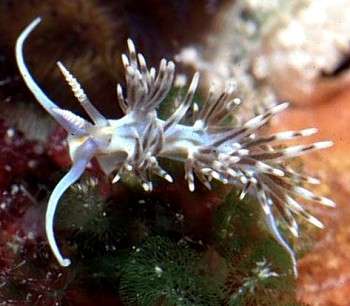
Dear Bill:
Here are photos of the second species of Dondice common in the Caribbean.
These photos of Dondice occidentalis (Engel, 1925) were also taken by Jeff Hamann of El Cajon, California, on our March 1992 Belize collection trip. The D. occidentalis were notably smaller than the specimens of Dondice parguerensis collected on this trip, ranging in size from 14 to 20 mm. We collected D. occidentalis at several Cayes, including Ranguana Caye (photos shown here) where the specimens were found on hydroids, not the algal substrate shown in the photo.
Best regards,
Dave Behrens
Sea Challengers
dave@seachallengers.com
Behrens, D., 1999 (Nov 10) Dondice occidentalis from Belize. [Message in] Sea Slug Forum. Australian Museum, Sydney. Available from http://www.seaslugforum.net/find/1509Dear Dave,
Thanks very much to you and Jeff Hamann. I am sure it will help Phanor to check his identification.
Best wishes,
Bill Rudman.
Re: Dondice occidentalis from Colombia
October 23, 1999
From: Phanor Montoya
Dear Bill,
Ok, now I have more time to tell you about the nudibranch I found!
Doing some skin diving close to the beach, here in Santa Marta, I found 25 nudibranchs all from the same species I think. I found in shallow water, like 2-3 meters (6-10 feet).
I collected one and took it to my university. I also took some pictures of it, but the film did not go well. I looked in Marcus (1976) and in Humman (1996) for some pictures of the nudibranch and its characteristics and some teachers told me that it seems to be Dondice occidentalis.
Now, I am going to collect another animal and I will take a picture with a good camera. I will send some pictures to you.
Thanks again, and excuse my English
I hope you can understand!
Phanor Montoya
phamont@eudoramail.com
Montoya , P., 1999 (Oct 23) Re: Dondice occidentalis from Colombia. [Message in] Sea Slug Forum. Australian Museum, Sydney. Available from http://www.seaslugforum.net/find/1452Dear Phanor,
I'm glad you've found an animal which is plentiful enough to work with. I look forward to seeing some photos. And your English is great.
Best wishes,
Bill Rudman.
Dondice occidentalis from Colombia
October 21, 1999
From: Phanor Montoya
Hi! how you doing?
I have seen the message from Anne. It was so helpful. Now I´m trying to get those books, I found them at the amazon books online store.
In September, a scuba diver found a nudibranch in the carribean coast of Santa Marta. It was found in a mud, sandy bottom with algae. It´s a small (2.5 cm) white nudibranch with lines of cerata in both sides of the body. The ceratas are red, almost brown. It has just one pair of rinophores on the head. We have the nudibranch in an small marine aquarium.
I have identified it as Dondice occidentalis. If you have or know where I can get information about it please let me know.
thanks again.
Phanor
phamont@go.com
Montoya, P., 1999 (Oct 21) Dondice occidentalis from Colombia. [Message in] Sea Slug Forum. Australian Museum, Sydney. Available from http://www.seaslugforum.net/find/1327Dear Phanor,
Glad to hear you have found a nudibranch and have identified it. If you can send a photo or drawing I am sure someone will be able to confirm its identity for you.
The only references on Dondice occidentalis I know of are basically about its anatomy and taxonomy. Two fairly recent ones which will give you references to earlier works are:
•Eyster, L.S. (1980) Distribution and reproduction of shell-less opisthobranchs from South Carolina. Bulletin of Marine Science, 30(3): 580-599.
•Thompson, T.E. (1980) Jamaican opisthobranch molluscs: II. Journal of Molluscan Studies, 46(1): 74-99.
Your mention of Dondice reminds me of a very interesting aeolid from the Caribbean which would be quite exciting to study if you could find it. It was discovered about 10 years ago in Puerto Rico and apparently lives exclusively on the jellyfish Cassiopea. Cassiopea is the jellyfish which is often found in sheltered shallow waters. It lives upside down so that the sunlight can get to its tentacles which are full of symbiotic algae. It would be very interesting to see if the aeolid also had algal cells alive in it tissues. It might be possible to keep the jellyfish alive in an aquarium, with the aeolids living on it. It would certainly be worth looking for. Its name is Dondice parguerensis, and the reference is:
•Brandon, M., & Cutress, C.E. (1985) A new Dondice (Opisthobranchia: Favorinidae), predator of Cassiopea in southwest Puerto Rico. Bulletin of Marine Science,(1): 139-144.
Best wishes,
Bill Rudman
